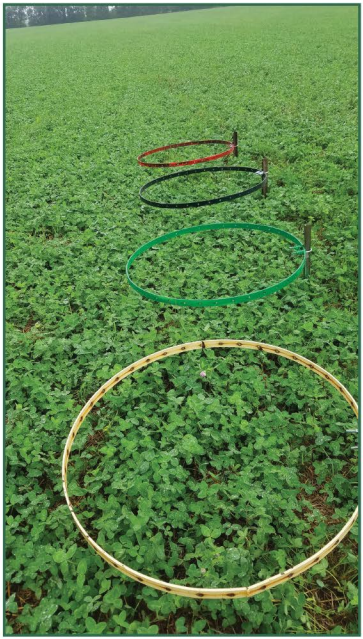Hay Field Ring Experiment Findings
As part of our ongoing research trials, Matt Gooding completed an experiment where he applied both GMS and dry fertilizer into small rings in a hay field, and then compared the microBIOMETER, tissue, and soil tests from the rings (including a control plot). The test parameters are as follows:
The green and yellow rings received an application of the equivalent to 2 gallons per acre of GMS in the late evening in September.
The same evening, the black and red rings received an application equivalent to 300 pounds per acre of a 5-10-15 dry fertilizer with trace elements added.
After 4 days, Matt took cuttings and soil samples from the yellow and black rings (and from outside the rings). He also did a microBIOMETER reading from the soil removed for the soil test within minutes of it being removed.
After 22 days, Matt took the same samples as at 4 days. The results for the biometer test are located in Table 1, and the results for the tissue test are in Table 2. We have not included the results for the soil tests as they showed nothing of interest and very little change between any of the sample times.
Some additional notes:
a. The field received adequate rainfall throughout the trial period, including a small rain the night of the applications.
b. The field received a 2 gallon per acre application of GMS two weeks before this experiment was conducted.
c. This field has been on the Growers Program since the late 1950s, so it has received a lot of high-calcium limestone and no dry fertilizer application over that time.
d. The dry fertilizer used in this experiment was first ground up, making it more available than if it had not been.
e. The temperature was unusually high throughout the trial period, with daytime temperatures between 70-85 degrees and nighttime temperatures going no lower than 50 degrees.
Right off the bat, we would like to point out that this field has benefited immensely from high-calcium limestone and clean fertilizer applications for decades, which surely affects the results of a test like this. Some of the results may surprise long-time Growers customers, but we believe that the calcium and grinding of the fertilizer has helped it in this experiment by dampening its toxic components and making it more available. Regardless, if you examine the results you will see some patterns become clear.
microBIOMETER
The microBIOMETER is a relatively new test we are experimenting with. It is an in-field test that gives the total biomass and a bacteria-fungus ratio (in percent of total biomass) of the microbes present in the sample of soil. You can visit their website for more information, but generally a higher total number (in micrograms) of biomass means more microbes present, and the higher the fungal ratio the better. This is because fungus does a couple of things better than bacteria: 1. They are better at breaking down tough to digest plant material; and 2. They create microfilament networks through the soil that transport nutrients further distances than bacteria are able to. Because of the lack of tough, woody material in agricultural fields, there is usually more bacteria than fungus present, but this can be changed to a degree with good farming practices, such as the addition of more organic matter to be broken down, preventing toxic substances (such as dry fertilizer) from entering the field, making it easier for it to form filament networks by creating better soil tilth, growing a healthier plant, which will feed the microbes more, and not over-tiling (which disturbs the filament networks).
Some observations from the microBIOMETER results:
In Table 1, we see
The bacteria-fungi ratios did not change much between the control and GMS samples, or between the two time periods for those two parts. There was, however, a large drop in fungal mass in the 4 day sample from the black ring.
Total biomass numbers increased quite substantially in both GMS rings.
Total biomass dropped substantially in the dry fertilizer ring in the 4 day sample, but had recovered by the 22 day sample.
We believe these results can be easily explained by the impurities present in the dry fertilizer, which would have initially harmed the microbes before the natural health of their communities and the soil reversed those negative effects. Likewise, the purity and availability of GMS would explain the increase in microbe biomass over both time periods.
TISSUE TESTS
Some observations:
In comparing the GMS to the dry fertilizer plots, the analyses of the macronutrients and crude protein are comparable, with the GMS rings usually a bit higher.
a. However, notice that after an initial large increase in the readings of micronutrients in the black ring (4 day samples) compared to the control, they all drop off quite significantly by the 22 day sample (red ring). We believe this shows that while the dry fertilizer may have provided an initial boost to the plant, it did not last and was not reflected in the tissue the plant had formed by the time the 22 day sample was taken.
b. Likewise, notice that after a minor increase in micronutrient levels in the yellow ring, the numbers either mostly stayed around the same or increase further by the 22 day sample. We believe this sustained increase is due to the balanced analysis of GMS, which encourages healthy tissue growth and improves the health of soil microbes, which will then provide more benefits to the plants.
i. Remember that this field has been on the Growers Program for decades, so the control group should reflect the same benefits from that as the GMS rings. Hence, similar tissue analyses numbers.
There is surely more helpful information to be found in this data, so please take a look for yourself! Almost 4 months later, the saved soil samples used for soil and bio-meter tests were run again through the bio-meter. The results (below) speak of the long-term impact GMS application has on soil biology.
This is an excerpt from the Early Fall Growers Solution (2022) written by Zach Smith, Product and Training Specialist.
Signup for our newsletter to stay in the loop




